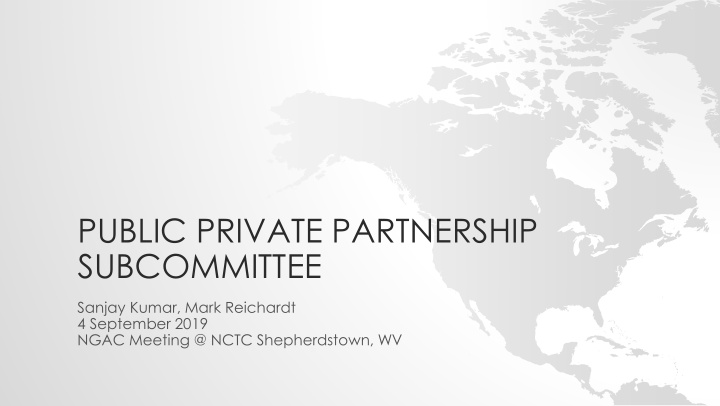



PUBLIC PRIVATE PARTNERSHIP SUBCOMMITTEE Sanjay Kumar, Mark Reichardt 4 September 2019 NGAC Meeting @ NCTC Shepherdstown, WV
PPP SUBCOMMITTEE SCOPING PAPER • Discussed and approved by Subcommittee members 29 July • Purpose: • Identify potential areas of PPP engagement for the NSDI • Articulate the value proposition / benefits necessary to establish and sustain such arrangements • Approach: • Examine Case Studies on successful / unsuccessful PPPs • Summary studies of 2-3 current PPPs • Identify key components of successful PPPs • Determine scope of partnerships desired • Assess available geospatial data produced and made available by government and industry Identify gap areas ripe for potential PPPs • • Examine existing policies, laws, regulations that may impact establishment of PPPs • Recommend business models
OUTCOMES DESIRED • Convey the benefits of and successful pathways for public and private parties to enter into PPPs • Identify next level of engagement desired for advancing the NSDI • Help to scale application of geospatial data to improve governance and address sustainable development
SUBCOMMITTEE MEMBERSHIP • Frank Avila • Sarah Battersby • Pat Cummens • Mike Hussey • Sanjay Kumar • Kevin Pomfret • Mark Reichardt • Amber Reynolds • Cy Smith • Gary Thompson
ACTIVITIES TO DATE • Initial Kick off meeting 29 July 2019 by teleconference • PPP roundtable with United Nations Global Geospatial Information Management (GGIM) delegates 5 August 2019
NGAC TABLE GROUP DISCUSSION Please share your insights regarding the following questions: Based on your experiences, what are some of the key components that make a successful business partnership? What are the cautions? Can you identify any examples within the greater geospatial community of successful partnerships? What contributed to their success? What is their business model?
SUCCESSFUL PPP CHARACTERISTICS FROM LITERATURE REVIEW / CASE STUDIES • Extensive preparation by all parties • Shared Vision • Understanding of partner / key player goals • Shared risks and rewards for all parties involved identified • Defined terms for IPR, ownership, licensing • Clearly defined decision-making process • Frequent communications • Maintain a “fair deal” structure • Include trust as a core value • Thorough assessment of policies, laws, regulations
Recommend
More recommend